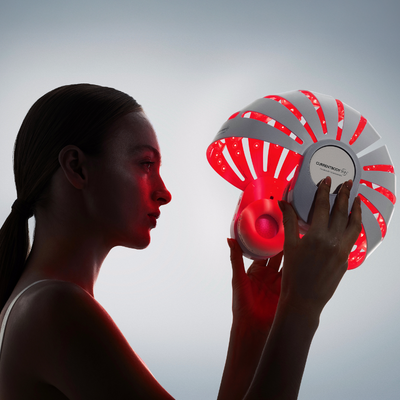Discover how to reduce redness on the face and calm flushed, blotchy skin at home.
Facial redness is a common and often misunderstood skin concern that affects millions of people worldwide. From red cheeks in adults to persistent redness on the face, it can appear as flushing, blotchiness or skin that always seems to look red.
Often concentrated across the cheeks, nose and chin, facial redness, facial flushing, and red blotchy skin on the face can feel distressing and difficult to manage. Following the advice of board-certified dermatologists, Dr. Shah and Dr. Maxfield, we explore what causes facial redness, common triggers, and how LED light therapy may help reduce the appearance of redness at home.
By understanding why your skin reacts the way it does, you’ll be better equipped to minimise flare-ups and achieve a calmer, more even-looking complexion.

What causes facial redness?
The causes of skin redness on the face aren’t always clear-cut, but genetics, skin sensitivity and environmental triggers can all play a role. Anything that encourages blood vessels near the surface of the skin to dilate can contribute to facial flushing and ongoing face redness.
Common triggers of facial redness include:
-
Alcohol
-
Spicy foods
-
Heat and sun exposure
-
Stress
Over time, repeated flushing can lead to persistent facial redness or blotchy skin on the face that takes longer to settle.
Why does facial redness look different for everyone?
“Facial redness is often a trial-and-error concern,” says Dr. Maxfield. Everyone’s skin reacts differently, and what works for one person may not work for another.
For some people, redness appears as red cheeks that flare after heat or exercise. For others, it may show up as uneven redness, flushing that lasts longer than expected, or a face that looks constantly flushed.
Dr. Maxfield advises treating redness-prone skin as sensitive-looking skin. “Avoid skincare and makeup containing isopropyl alcohol, witch hazel, essential oils and mechanical scrubs,” he explains.
Instead, opt for calming ingredients like niacinamide, liquorice extract and barrier-supporting ceramides. And always wear daily SPF.
When redness is accompanied by blemishes or texture
Some people experience red blotchy skin on the face alongside small bumps or uneven texture. Although it may resemble spots, treating it aggressively can often make redness worse.
“Sulphur is very, very effective and probably one of the most underrated skincare ingredients that exists,” says Dr. Shah, noting its ability to help calm the appearance of redness while keeping skin balanced.
For those noticing thicker-looking skin or visible pores alongside redness, Dr. Shah recommends gentle preventative care: “Niacinamide can help reduce excess oil and refine the look of pores,” he says, especially when used early and consistently.

Does red LED light therapy help facial redness?
Absolutely. LED light therapy has become increasingly popular for helping to reduce the appearance of facial redness and calm flushed skin.
LED (light-emitting diode) light therapy is well known for its ability to support skin balance and soothe visible redness. Red and near-infrared wavelengths are commonly used to help calm facial flushing and improve overall skin comfort.
Often seen in clinics and now available in at-home devices, LED therapy feels warm and soothing, offering a calming and comfortable 10-minute pause in your daily skincare routine.
Regular use may help:
-
Reduce the appearance of facial redness
-
Calm flushed faces
-
Improve the look of red blotchy skin on the face
-
Support a more even-looking complexion
Some wavelengths are also associated with comforting, soothing effects, making them particularly appealing for redness-prone skin.

How to get rid of red blotchy skin on the face
If you’re searching for how to get rid of red blotchy skin on the face, consistency and gentle care are key.
Focus on:
-
Fragrance-free skincare
-
Avoiding known flushing triggers
-
Daily sun protection
-
Calming skincare technology like an LED face mask
For adults experiencing red cheeks or frequent flushing, combining LED light therapy with a barrier-supporting routine may help improve the appearance of redness over time.
How to get rid of red cheeks and reduce face redness
If your main concern is how to get rid of red cheeks, avoid over-exfoliating or using harsh actives that can aggravate redness on the face. Instead, prioritise calming, hydrating products and therapies designed to support sensitive-looking skin.
LED light therapy can be a useful addition, helping to calm facial flushing and improve the appearance of skin redness on the face when used consistently.
If facial redness persists or worsens, a qualified skin professional can help guide you towards a routine tailored to your skin.





